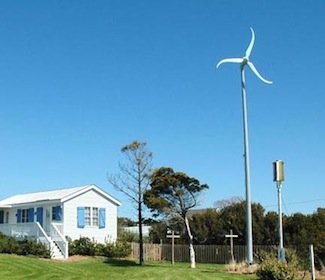Green Building Blocks: Energy Independence!
This is it. This is the top block on our Green Building Block Wall. The greenest of the green. An off-grid home, completely self-reliant and self-powered.
Most green homeowners share the dream of a 100% off-the-grid home that generates all the energy it needs on-site with renewable energy. When the need for any type of non-renewable fossil fuels is eliminated, a homes' environmental footprint shrinks to near zero.
At this highest level of green building, a home uses little to no outside sources of energy. The power needed to run the household is created with totally renewable resources: the sun, the wind, sustainably-managed forests, even running water and the heat from the earth itself. But due to the high initial investment costs involved, and the amount of power required to run a home, going off-grid remains the most difficult (and most expensive) Building Block.
Before any home can start harnessing renewable energy on-site, the energy and resource savings that are realized by all of our other Building Blocks must first be utilized. After all, what's the point of spending thousands of dollars installing renewable energy systems only to waste that precious power on inefficient design, construction, appliances, etc.?
Examples of Zero Carbon Energy Systems
A home that utilizes renewable energy requires very little or no energy from the outside grid. Such a home can use solar or wind energy, geothermal heating and cooling, solar hot water heating, small hydropower, or any combination of the above to achieve energy independence. Some homeowners start off small with renewable energy and a grid-connected home, using renewable energy to supplement their traditional energy supplies. As they become comfortable with the renewable systems, and as finances allow, the systems can be added to and upgraded to supply more and more independent power, up to a point where the home can detach from the grid and be completely self-sufficient. Another option is to stay connected to the grid, and send excess power created at home back into the grid, in effect selling energy back to the power company. The possibilities are almost limitless.Follow Lower Building Blocks First
As mentioned above, energy independence is at the top of our green wall for a reason. Taking advantage of all previous Blocks is critical to any green home, especially one that relies on renewable power.To best utilize any renewable energy source, the home should be designed and built to be as energy-efficient as possible. If most or all of our other Building Blocks are followed, your home will be ready-made for renewables: extremely efficient and sited properly to take advantage of passive solar energy as well as photovoltaics and wind turbines. All steps should be taken according to our Building Blocks to design and build a very airtight, well-insulated home and outfitted with the most energy-efficient appliances, water-using devices, and heating/cooling systems possible. Only after these steps have been taken should a homeowner consider becoming energy independent.
Following any of our Building Blocks will help shrink a homes' environmental footprint; follow the easier, less expensive Blocks first to see the biggest savings with the least difficulty, then follow the Blocks up the wall as they become progressively more difficult to achieve. Once the top of the wall has been reached, your green home is ready to take the final step of reaching true energy-independence. In other words, save as much energy in and around the home as possible first, then start researching and implementing renewable energy systems to become a carbon zero, completely green home. The journey may be a long one, and you may never reach the end, but along the way you will have done your part to make your home part of the solution to our planets' energy and pollution problems.
For more information about residential solar power, click here.
To learn more about residential wind power, click here.
To return to the Building Blocks of Green main page, click HERE.
comments powered by Disqus




























































































































































































